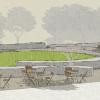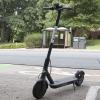GDOT's (Non-Flag) Suggestions for Prince Avenue Safety
City Dope

Photo Credit: Krysia Haag
The photo illustration shows Normaltown with bike lanes and a mid-block crosswalk.
Yet another study of Prince Avenue?
The Georgia Department of Transportation's newly released safety audit is well-illustrated, and drills down to some specific recommendations, although more expensive fixes like pedestrian refuge islands and bike lanes get short shrift. Mostly, the new report outlines specific tweaks to sidewalks, signs and crosswalks, and closing or narrowing some driveways. Those are the sort of changes that ACC Transportation Director David Clark thinks GDOT might be able to make without specific additional funds. "I suspect you're going to see some changes, probably in the next year or two," he told Flagpole. "Whether or not they have the funding [for additional changes], I don't know."
The report does recommend additional changes, ranging from adding medians and pedestrian refuge islands to adding bike lanes, any of which would likely require widening the street's curb-to-curb width. And widening is expensive, Clark said, partly because underground and electrical utilities often must be moved. Among the report's recommendations are:
• Add "raised islands and medians to calm traffic."
• Change intersections and turn lanes to provide shorter, safer crosswalks.
• Add sidewalks and sidewalk buffers where missing.
• "Initiating a parking study to determine parking needs."
• "Close excessive driveways" and promote connectivity between parking lots.
• Provide bike lanes "to establish predictable space for cyclists."
• ”Consider" three-laning all or parts of Prince to calm traffic and provide a consistent center turn lane.
• Add overhead flashers to existing midblock crosswalks; move the Grit crosswalk across Newton Street and add a pedestrian island.
• Add a left-turn lane adjacent to the Social Security office.
• Add a median refuge island at Georgia Avenue.
• Better synchronize stoplights near the hospital.
• Update wheelchair ramps at pedestrian crossings.
• Consider a midblock crosswalk at the Health Sciences campus.
• Realign Park Avenue directly opposite Talmadge Drive.
Changes to the in-town (Milledge Avenue to downtown) portion of Prince fall to Clark's department, because that portion of the street is locally owned, rather than being a state route. ACC Traffic Engineer Steve Decker told Flagpole that, while the report asserts that excessive speeding is a problem, "the collected data does not support a major speeding problem. Drivers in Athens tend to drive 5–10 miles per hour over the speed limit everywhere, which includes Prince in some areas. The Athens Police Department, like other local agencies, has their hands somewhat tied, as the State of Georgia regulates how local agencies may write speeding citations." Clark thinks speeding is mostly a problem between Barber Street and Milledge, where the street is something of a straightaway.
Proposed changes to Prince have been controversial (and mostly nonexistent) since Clark's department deemed it "feasible" in 2004 to reduce the in-town portion from four lanes to three, with bicycle lanes added. A political firestorm followed (driven partly by members of Prince Avenue Baptist Church, which has since moved to Oconee county), and a majority of the then-commission voted to remove any mention of Prince from the the county's Bicycle Master Plan, then voted down three-laning in 2005. Eventually, after an election, a somewhat different group of commissioners restored Prince to the plan, but no further action has been taken.
The issue will come up again in about three years, when Prince is due for repaving, commissioner Kelly Girtz says. "I still think [a road diet] is a viable engineering solution" that could allow bicycle lanes and medians to be added to the in-town portion, he told Flagpole. "Obviously, not everybody agrees with that."
Clark floated a number of pedestrian safety improvements at a June work session that the mayor and commission have yet to act on. He said his department could again study such a proposal. Since 2004, traffic has increased by about 9 percent to 19,000 cars a day, still short of the 20,000 figure at which a road diet might increase congestion.












comments